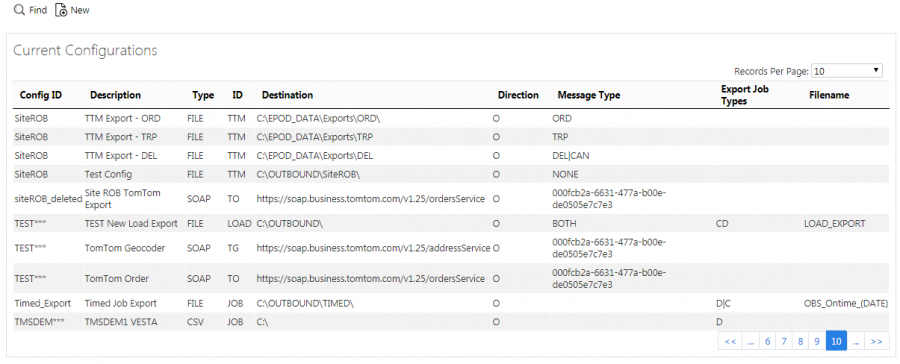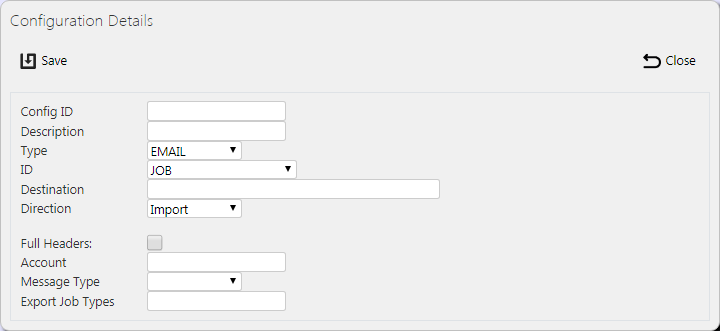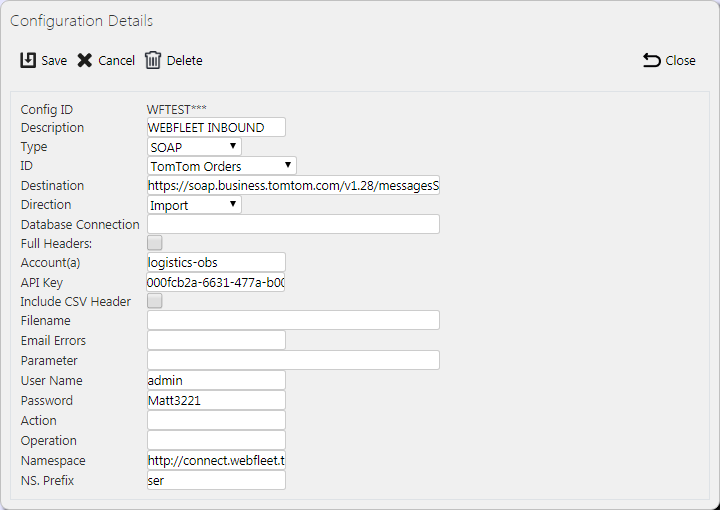Auto-Export
This screen allows you to create, delete and amend import and export parameters. These are held against a configuration ID that you can attached to a site or job groups through the appropriate maintenance screen. You can configure multiple different types of imports and exports under the same config ID. If you configure export on the system, the process will import and export based on the configurations attached to the site or job group.
You can filter data by:
- Config ID.
- Description.
- Type - a drop-down list of the different import/export transfer types (for example, FTP, SOAP, etc).
- ID - the export type (for example, JOB, LOAD, TPN, TTM, etc).
- Direction - a drop-down list. You can choose Inbound, Outbound, All or Device to see interfaces designed to be used by the mobile device only.
Once you have entered the criteria, click Search. The screen will display a table of all the matching data. Any plain text boxes will match data that contains what you enter as the criterion.

Import/Export Configurations Search Panel and Results table
The results table will display a single line per configuration found.
The results table shows the following columns:
- Config ID - the main configuration ID that will be attached to the site or job group.
- Description - the description of the import/export being configured as part of the Config ID.
- Type - the transfer type (e.g. Email, File, SOAP, etc).
- ID - the import/export type. Standard configurations are one of the following:
- JOB - standard OBS XML updates per job.
- LOAD - standard OBS XML Updates per load. This include the job information if required.
- POD/POD2 - export of completion reports (i.e. POD, POC, Service Report) to external systems (usually document management systems).
- TTM - export of load, order and tracking information to CALIDUS Portal TTM.
- VEHICLECHECKS - export of completed vehicle defect checks.
- JOBSWAP - export of job swap information to transport management systems (e.g. CALIDUS TMS).
- PF/PALLEX/FORTRACK/TPN/GAP861/Palletline/HazChem - pallet network tracking system specific exports.
- TomTom Geocoder - service to geocode addresses.
- TomTom WEBFLEET Order - service to export orders to TomTom WEBFLEET for tracking and execution.
- TomTom WEBFLEET Order (Import) - service to import debrief information from TomTom WEBFLEET.
- TomTom Device/Driver - device-specific settings to determine logon information from connected TomTom WEBFLEET systems.
- DiPS Orders - import from DiPS route optimisation software.
- PART - bespoke Partnerlink JobShare import.
- EBB - bespoke EBB import.
- Invoice - export of invoice information.
- Here Geocoder - service to geocode addresses.
- Destination - a folder or network specification for file- or FTP-based transfers.
- Direction - inbound to (I) or Outbound from (O) CALIDUS ePOD. For TomTom Device/Driver messages, this defaults to "Device".
- Message Type - message-specific. For example, for TTM export type, this indicates the individual message types being sent.
- Export Job Types - message-specific. This indicates whether collections (C), deliveries (D) or services (S) are exported with this message.
- Filename - a pattern to match to build a file for export, or to find for import file-based transfer types.
New Import/Export Configurations
You can create new configurations by pressing the provided New button at the top of the screen.

New Import/Export Configuration Pop-up
You can enter the following details, depending on the type and message:
- Config ID - the main configuration ID that will be attached to the site or job group.
- Description - the description of the import/export being configured as part of the Config ID.
- Type - the mechanism by which the document will be exported. You can select one from a drop-down list of:
- FTP - flat-file export to FTP server.
- EMAIL - attachment to an email.
- FILE - flat-file export to a local or shared directory.
- SOAP/POST - delivery as the content of a web service request.
- ID - the Import/Export type. Standard configurations may be selected from a drop-down list of the following:
- JOB - standard OBS XML updates per job.
- LOAD - standard OBS XML Updates per load. This include the job information if required.
- POD/POD2 - export of completion reports (i.e. POD, POC, Service Report) to external systems (usually document management systems).
- TTM - export of load, order and tracking information to CALIDUS Portal TTM.
- VEHICLECHECKS - export of completed vehicle defect checks.
- JOBSWAP - export of job swap information to transport management systems (e.g. CALIDUS TMS).
- PF/PALLEX/FORTRACK/TPN/GAP861/Palletline/HazChem - pallet network tracking system specific exports.
- TomTom Geocoder - service to geocode addresses.
- TomTom WEBFLEET Order - service to export orders to TomTom WEBFLEET for tracking and execution.
- TomTom WEBFLEET Order (Import) - service to import debrief information from TomTom WEBFLEET.
- TomTom Device/Driver - device-specific settings to determine logon information from connected TomTom WEBFLEET systems.
- DiPS Orders - import from DiPS route optimisation software.
- PART - bespoke Partnerlink JobShare import.
- EBB - bespoke EBB import.
- Invoice - export of invoice information.
- Here Geocoder - service to geocode addresses.
- Destination - this depends on the export mechanism:
- FTP - FTP Server and directory in format 'ftp://server/directory'.
- FILE - directory in format 'X:\directory\' or '\\server\directory\'.
- SOAP/POST - web service address.
- Parameter/Job Types - collection, delivery or service type jobs can be included in the export.
- Format - for POD exports:
- HTML - the native format of CALIDUS ePOD. This is configured to fit on one A4 sheet where applicable. Pagination is included when the report is printed.
- Image
- Types TIFF, JPEG or PNG, with TIFF compression enabled if required (ZIP or FAX).
- PDF - the report is converted automatically from the HTML for A4 paper. Pagination is supported.
- Filename - file or attachment name. This can be made up of fixed and variable information:
- "date" - the current date, formatted as "YYYYMMDD".
- "time" - the current time, formatted as "HHMMSS".
- "uid" - a unique sequence per file per run, formatted as "0000".
- Any field from the Job data. So, for example, if a tag <EPL_EXT_REF> is found, this will be replaced with the data value of EPOD_JOB.EPL_EXT_REF.
For email export, the file is exported to the customer email address and one other optional email address (a Site or central email address). This mechanism requires a connection to the customer email server from the CALIDUS ePOD server.
For SOAP exports, you can also enter the following parameters:
- Parameter.
- User Name.
- Password.
- Action.
- Operation.
- Namespace.
- NS Prefix.
These are usually specific to the webservice method.
For FTP and POST exports, the following parameters may also be entered:
- Parameter.
- User Name.
- Password.
When changes are complete, you can click Save to save the changes, or Close to close the pop-up without saving the changes.
View/Edit Import/Export Configurations
You can view or edit configurations by clicking the Select action button against the line in the table. The screen will display a pop-up showing all the details of the configuration.

View/Edit Import/Export Configurations Pop-up
You can edit the configuration by clicking the provided Edit button.
The same fields may be edited here as when entering a new configuration, bar the Config ID.
When changes are complete, you can click Save to save the changes. If you don't want to save your changes, you can click Cancel to stop editing, or Close to close the pop-up without saving the changes.
You can click the Delete button to delete the configuration - the screen will ask you to confirm before the configuration is deleted.